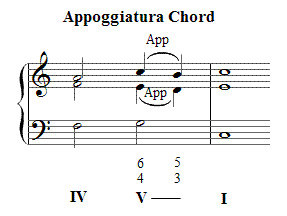APPENDIX A: VOICE LEADING OVERVIEW
The Double Appoggiatura (Cadential 6 4 Chord)
Like other voice leading devices, it is possible to combine more than one appoggiatura. The most common example of this is the Cadential 6 4 chord. This chord is made up of two appoggiaturas to the dominant chord on the 6th and 4th from the bass, (which must be the root of the chord). These descend diatonically to the 5th and 3rd of the chord to form the normal dominant chord:

The notes of the two appoggiaturas combine with the bass to form a tonic chord in second inversion. However, it is important to note that this is just a voice leading elaboration of the underlying dominant chord. This chord is a very common way of elaborating V - I cadential patterns which is why it is referred to as a cadential 6 4 chord.
This chord can be further elaborated in various ways. The following shows just one of these, where the chord is preceded by an augmented 6th chord which is created by two chromatic passing notes in the bass and tenor parts:

See Book Chapter 3 Part 4 for more on the appoggiatura chord and see the section in this appendix on the chromatic passing note.
See also the separate section on chromatic appoggiaturas.
Next Topic: The Emancipated Dominant 7th chord

